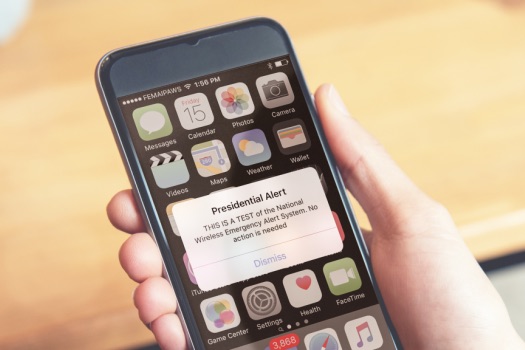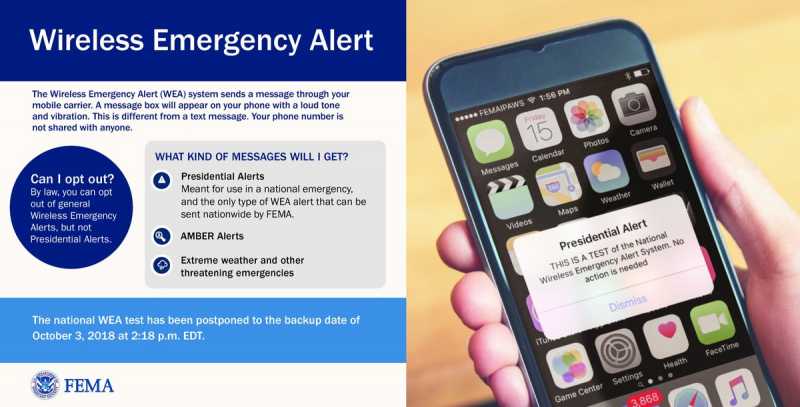- Posts: 9427
- Thank you received: 219
- Forum
- Life Up the Hill
- Scanner & Emergency Info, Weather Forecasts
- Oct 3: National Test of Emergency Alert System and Wireless Emergency Alerts
Oct 3: National Test of Emergency Alert System and Wireless Emergency Alerts
- MountainTownAlerts
-
 Topic Author
Topic Author
- Mountain Legend
-

Less
More
16 Sep 2018 15:42 - 17 Sep 2018 19:15 #1
by MountainTownAlerts
IPAWS National Test of the Emergency Alert System (EAS) and Wireless Emergency Alerts (WEA)
Thursday, September 20, 2018
The Federal Emergency Management Agency (FEMA), in coordination with the Federal Communications Commission (FCC), will conduct a nationwide test of the Emergency Alert System (EAS) and Wireless Emergency Alerts (WEA) on September 20, 2018. The WEA portion of the test commences at 2:18 p.m. EDT, and the EAS portion follows at 2:20 p.m. EDT. The test will assess the operational readiness of the infrastructure for distribution of a national message and determine whether improvements are needed.
The WEA test message will be sent to cell phones that are connected to wireless providers participating in WEA. This is the fourth EAS nationwide test and the first national WEA test. Previous EAS national tests were conducted in November 2011, September 2016, and September 2017 in collaboration with the FCC, broadcasters, and emergency management officials in recognition of FEMA’s National Preparedness Month.
The EAS is a national public warning system that provides the President with the communications capability to address the nation during a national emergency. The test is made available to EAS participants (i.e., radio and television broadcasters, cable systems, satellite radio and television providers, and wireline video providers) and is scheduled to last approximately one minute. The test message will be similar to regular monthly EAS test messages with which the public is familiar. The EAS message will include a reference to the WEA test:
“THIS IS A TEST of the National Emergency Alert System. This system was developed by broadcast and cable operators in voluntary cooperation with the Federal Emergency Management Agency, the Federal Communications Commission, and local authorities to keep you informed in the event of an emergency. If this had been an actual emergency an official message would have followed the tone alert you heard at the start of this message. A similar wireless emergency alert test message has been sent to all cell phones nationwide. Some cell phones will receive the message; others will not. No action is required.”
Cell towers will broadcast the WEA test for approximately 30 minutes beginning at 2:18 p.m. EDT. During this time, WEA compatible cell phones that are switched on, within range of an active cell tower, and whose wireless provider participates in WEA should be capable of receiving the test message. Some cell phones will not receive the test message, and cell phones should only receive the message once. The WEA test message will have a header that reads "Presidential Alert" and text that says:
“THIS IS A TEST of the National Wireless Emergency Alert System. No action is needed.”
The WEA system is used to warn the public about dangerous weather, missing children, and other critical situations through alerts on cell phones. The national test will use the same special tone and vibration as with all WEA messages (i.e. Tornado Warning, AMBER Alert). Users cannot opt out of the WEA test.
If circumstances, such as a major weather event, cause the IPAWS National Test to be postponed, the back-up date is Wednesday, October 3, 2018.
Video: www.fema.gov/media-library/assets/videos/169554#
Frequently Asked Questions
1. What is the Emergency Alert System?
The Emergency Alert System (EAS) is a national public warning system that requires EAS Participants (i.e. radio and television broadcasters, cable systems, satellite radio and television providers, and wireline video providers) to provide the President with the communications capability to address the nation during a national emergency. The system also may be used by state, local, tribal, and territorial authorities, in cooperation with EAS Participants, to deliver important emergency information, such as weather information, AMBER alerts, and local incident information targeted to specific areas.
FEMA, in partnership with the Federal Communications Commission and National Oceanic and Atmospheric Administration, is responsible for implementation, maintenance, and operations of the EAS at the federal level. The President has sole responsibility for determining when the national-level EAS will be activated. FEMA is responsible for national-level EAS, tests, and exercises.
2. What is the Integrated Public Alert and Warning System (IPAWS)?
IPAWS is a national system for local alerting. It provides the means for disseminating authenticated emergency alert and warning messaging from emergency officials to the public through:
The FEMA IPAWS Program is responsible for implementing a national public alert and warning system, ensuring that the President can send alert and warning messages to the public under all conditions, and enabling its use by federal, state, local, tribal, and territorial officials during local emergencies. Executive Order 13407 tasked the Department of Homeland Security (DHS) to assign FEMA with developing, operating, integrating, and maintaining IPAWS, plus future connections alerting technologies.
4. Why is FEMA conducting a joint WEA and EAS test?
The nationwide WEA and EAS test will provide FEMA with valuable information on the effectiveness of WEA accompanying an EAS for a national Presidential alert. Nationwide EAS tests have been conducted the past two years. 2018 will be the first year for the nationwide test to include both EAS and WEA. In the event of a national emergency and/or disaster, WEA is just one of several channels that will be used to warn the public and communicate what protective action to take. Successful alerting requires using multiple channels to ensure the largest portion of the public possible receives an alert. Testing allows FEMA to evaluate a portion of the nation’s alerting capabilities.
Nationwide EAS-WEA testing helps FEMA and industry participants to maintain and improve alert and warning capabilities at the federal, state, local, tribal, and territorial levels, together with testing the nationwide WEA capability for the first time.
5. What are Wireless Emergency Alerts (WEAs)?
WEAs are emergency messages sent by authorized government alerting authorities through participating wireless providers. To date, WEAs have been issued for extreme weather and other threatening emergencies in your area, and AMBER alerts. Presidential Alerts are to be used during a national emergency, though none have been sent to date. This will be the first national WEA test. More information on WEA can be viewed online at www.fema.gov/frequently-asked-questions-...ess-emergency-alerts .
6. What types of alerts are sent through WEA?
There are presently three categories of alerts sent through WEA: imminent threat alerts about threatening emergencies in an area including extreme weather, AMBER alerts, and Presidential alerts about emergencies of national consequence. Users may opt of receiving alerts in the imminent threat and AMBER categories but cannot opt out of receiving Presidential alerts.
10. How will I know the difference between a WEA and a regular text message?
WEA includes a special tone (some describe it as quite loud) and a vibration, both repeated twice. A distinctive WEA message dialog box also appears on the mobile device’s screen.
11. Does a member of the public sign up for WEA alerts?
No, one of the significant benefits of WEA is there is no need for a person to have to sign up to receive a WEA alert. More than 100 providers, including the largest providers participate in the WEA program.
12. Why can I not opt out of the Presidential Alert category on my cell phone?
The Communications Act of 1934 established the authority for the President to use certain private sector communications systems for priority communications, such as sending alert and warning messages to the public, during national emergencies. The implementation of this legislation is what enables the Emergency Alert System to be used by government authorities at all levels of government to send alert and warnings via private sector radio, television and cable stations in coordination with the private sector station owners. In 2006, The Warning, Alert, and Response Network (WARN) Act of 2006 prompted the Federal Communications Commission to adopt regulations enabling the wireless industry to participate in the distribution of public alerts and warnings also. The WARN Act further established that the wireless alerting service should allow wireless subscribers the capability of opting out of receiving alerts, other than an alert issued by the President.
13. Why will some phones receive the alert and others will not?
Only WEA compatible cell phones that are switched on and within range of an active cell tower, and whose wireless provider participates in WEA will be capable of receiving the test message.
21. Will I be charged for the reception of this alert?
No, you will not be charged for this test alert, nor will you be charged for any EAS or WEA messages received.
22. Will the test alert be used to gather my private data?
No, both EAS and WEA are broadcasts and do not collect any of your data. This test is strictly a test designed to evaluate the effectiveness of the nation’s emergency alerting capabilities.
23. Does WEA know where I am?
No. WEA is not capable of tracking the location of anyone receiving a WEA alert.
26. Where can I provide feedback?
FEMA invites the public to send comments on the nationwide EAS-WEA test to FEMA-National-Test@fema.dhs.gov. Valuable information on the effectiveness of a national WEA capability using the Presidential alert category includes:
www.fema.gov/emergency-alert-test
Oct 3: National Test of Emergency Alert System and Wireless Emergency Alerts was created by MountainTownAlerts
IPAWS National Test of the Emergency Alert System (EAS) and Wireless Emergency Alerts (WEA)
Thursday, September 20, 2018
The Federal Emergency Management Agency (FEMA), in coordination with the Federal Communications Commission (FCC), will conduct a nationwide test of the Emergency Alert System (EAS) and Wireless Emergency Alerts (WEA) on September 20, 2018. The WEA portion of the test commences at 2:18 p.m. EDT, and the EAS portion follows at 2:20 p.m. EDT. The test will assess the operational readiness of the infrastructure for distribution of a national message and determine whether improvements are needed.
The WEA test message will be sent to cell phones that are connected to wireless providers participating in WEA. This is the fourth EAS nationwide test and the first national WEA test. Previous EAS national tests were conducted in November 2011, September 2016, and September 2017 in collaboration with the FCC, broadcasters, and emergency management officials in recognition of FEMA’s National Preparedness Month.
The EAS is a national public warning system that provides the President with the communications capability to address the nation during a national emergency. The test is made available to EAS participants (i.e., radio and television broadcasters, cable systems, satellite radio and television providers, and wireline video providers) and is scheduled to last approximately one minute. The test message will be similar to regular monthly EAS test messages with which the public is familiar. The EAS message will include a reference to the WEA test:
“THIS IS A TEST of the National Emergency Alert System. This system was developed by broadcast and cable operators in voluntary cooperation with the Federal Emergency Management Agency, the Federal Communications Commission, and local authorities to keep you informed in the event of an emergency. If this had been an actual emergency an official message would have followed the tone alert you heard at the start of this message. A similar wireless emergency alert test message has been sent to all cell phones nationwide. Some cell phones will receive the message; others will not. No action is required.”
Cell towers will broadcast the WEA test for approximately 30 minutes beginning at 2:18 p.m. EDT. During this time, WEA compatible cell phones that are switched on, within range of an active cell tower, and whose wireless provider participates in WEA should be capable of receiving the test message. Some cell phones will not receive the test message, and cell phones should only receive the message once. The WEA test message will have a header that reads "Presidential Alert" and text that says:
“THIS IS A TEST of the National Wireless Emergency Alert System. No action is needed.”
The WEA system is used to warn the public about dangerous weather, missing children, and other critical situations through alerts on cell phones. The national test will use the same special tone and vibration as with all WEA messages (i.e. Tornado Warning, AMBER Alert). Users cannot opt out of the WEA test.
If circumstances, such as a major weather event, cause the IPAWS National Test to be postponed, the back-up date is Wednesday, October 3, 2018.
Video: www.fema.gov/media-library/assets/videos/169554#
Frequently Asked Questions
1. What is the Emergency Alert System?
The Emergency Alert System (EAS) is a national public warning system that requires EAS Participants (i.e. radio and television broadcasters, cable systems, satellite radio and television providers, and wireline video providers) to provide the President with the communications capability to address the nation during a national emergency. The system also may be used by state, local, tribal, and territorial authorities, in cooperation with EAS Participants, to deliver important emergency information, such as weather information, AMBER alerts, and local incident information targeted to specific areas.
FEMA, in partnership with the Federal Communications Commission and National Oceanic and Atmospheric Administration, is responsible for implementation, maintenance, and operations of the EAS at the federal level. The President has sole responsibility for determining when the national-level EAS will be activated. FEMA is responsible for national-level EAS, tests, and exercises.
2. What is the Integrated Public Alert and Warning System (IPAWS)?
IPAWS is a national system for local alerting. It provides the means for disseminating authenticated emergency alert and warning messaging from emergency officials to the public through:
- Radio and television via the Emergency Alert System (EAS);
- Wireless phones via Wireless Emergency Alerts (WEAs);
- NOAA All Hazards Weather Radio via IPAWS-NOAA gateway; and
- Internet applications and websites via the IPAWS Alerts Feed.
The FEMA IPAWS Program is responsible for implementing a national public alert and warning system, ensuring that the President can send alert and warning messages to the public under all conditions, and enabling its use by federal, state, local, tribal, and territorial officials during local emergencies. Executive Order 13407 tasked the Department of Homeland Security (DHS) to assign FEMA with developing, operating, integrating, and maintaining IPAWS, plus future connections alerting technologies.
4. Why is FEMA conducting a joint WEA and EAS test?
The nationwide WEA and EAS test will provide FEMA with valuable information on the effectiveness of WEA accompanying an EAS for a national Presidential alert. Nationwide EAS tests have been conducted the past two years. 2018 will be the first year for the nationwide test to include both EAS and WEA. In the event of a national emergency and/or disaster, WEA is just one of several channels that will be used to warn the public and communicate what protective action to take. Successful alerting requires using multiple channels to ensure the largest portion of the public possible receives an alert. Testing allows FEMA to evaluate a portion of the nation’s alerting capabilities.
Nationwide EAS-WEA testing helps FEMA and industry participants to maintain and improve alert and warning capabilities at the federal, state, local, tribal, and territorial levels, together with testing the nationwide WEA capability for the first time.
5. What are Wireless Emergency Alerts (WEAs)?
WEAs are emergency messages sent by authorized government alerting authorities through participating wireless providers. To date, WEAs have been issued for extreme weather and other threatening emergencies in your area, and AMBER alerts. Presidential Alerts are to be used during a national emergency, though none have been sent to date. This will be the first national WEA test. More information on WEA can be viewed online at www.fema.gov/frequently-asked-questions-...ess-emergency-alerts .
6. What types of alerts are sent through WEA?
There are presently three categories of alerts sent through WEA: imminent threat alerts about threatening emergencies in an area including extreme weather, AMBER alerts, and Presidential alerts about emergencies of national consequence. Users may opt of receiving alerts in the imminent threat and AMBER categories but cannot opt out of receiving Presidential alerts.
10. How will I know the difference between a WEA and a regular text message?
WEA includes a special tone (some describe it as quite loud) and a vibration, both repeated twice. A distinctive WEA message dialog box also appears on the mobile device’s screen.
11. Does a member of the public sign up for WEA alerts?
No, one of the significant benefits of WEA is there is no need for a person to have to sign up to receive a WEA alert. More than 100 providers, including the largest providers participate in the WEA program.
12. Why can I not opt out of the Presidential Alert category on my cell phone?
The Communications Act of 1934 established the authority for the President to use certain private sector communications systems for priority communications, such as sending alert and warning messages to the public, during national emergencies. The implementation of this legislation is what enables the Emergency Alert System to be used by government authorities at all levels of government to send alert and warnings via private sector radio, television and cable stations in coordination with the private sector station owners. In 2006, The Warning, Alert, and Response Network (WARN) Act of 2006 prompted the Federal Communications Commission to adopt regulations enabling the wireless industry to participate in the distribution of public alerts and warnings also. The WARN Act further established that the wireless alerting service should allow wireless subscribers the capability of opting out of receiving alerts, other than an alert issued by the President.
13. Why will some phones receive the alert and others will not?
Only WEA compatible cell phones that are switched on and within range of an active cell tower, and whose wireless provider participates in WEA will be capable of receiving the test message.
21. Will I be charged for the reception of this alert?
No, you will not be charged for this test alert, nor will you be charged for any EAS or WEA messages received.
22. Will the test alert be used to gather my private data?
No, both EAS and WEA are broadcasts and do not collect any of your data. This test is strictly a test designed to evaluate the effectiveness of the nation’s emergency alerting capabilities.
23. Does WEA know where I am?
No. WEA is not capable of tracking the location of anyone receiving a WEA alert.
26. Where can I provide feedback?
FEMA invites the public to send comments on the nationwide EAS-WEA test to FEMA-National-Test@fema.dhs.gov. Valuable information on the effectiveness of a national WEA capability using the Presidential alert category includes:
- Whether your mobile device displayed one, more or no WEA test messages;
- The make, model and operating system version of your mobile device;
- Your wireless service provider;
- Whether the device was turned on and in the same location for at least 30 minutes after the start of the test (2:18 p.m. ET);
- The location of the device (as precise as possible), including the device’s environment (e.g. indoors or outdoors, rural or urban, mobile or stationary);
- Whether you are normally able to make calls, receive texts, or use apps at that location;
- Whether the mobile device was in use at the time of the alert (for a call or a data session);
- Whether anyone else at your location received the WEA test alert message.
www.fema.gov/emergency-alert-test
Last edit: 17 Sep 2018 19:15 by MountainTownAlerts. Reason: change in date
Please Log in or Create an account to join the conversation.
- MountainTownAlerts
-
 Topic Author
Topic Author
- Mountain Legend
-

Less
More
- Posts: 9427
- Thank you received: 219
17 Sep 2018 19:15 #2
by MountainTownAlerts
Replied by MountainTownAlerts on topic Oct 3: National Test of Emergency Alert System and Wireless Emergency Alerts
Due to severe weather across much of the East Coast and ongoing response efforts, the national emergency alert test has been postponed to the backup date of Oct. 3, 2018 at 2:18 PM EDT. If you have questions about the test, visit the FAQ at
www.fema.gov/emergency-alert-test
Please Log in or Create an account to join the conversation.
- GeorgeM
-

- Leaf Peeper
-

Less
More
- Posts: 38
- Thank you received: 10
18 Sep 2018 08:48 #3
by GeorgeM
Blessed is the man, who having nothing to say, abstains from giving wordy evidence of the fact. -- George Eliot (Mary Anne Evans)
Replied by GeorgeM on topic Oct 3: National Test of Emergency Alert System and Wireless Emergency Alerts
So, the test of the emergency alert system has been scrubbed because of emergency conditions on the East Coast. Think about that for a moment.
Blessed is the man, who having nothing to say, abstains from giving wordy evidence of the fact. -- George Eliot (Mary Anne Evans)
Please Log in or Create an account to join the conversation.
- Forum
- Life Up the Hill
- Scanner & Emergency Info, Weather Forecasts
- Oct 3: National Test of Emergency Alert System and Wireless Emergency Alerts
Time to create page: 0.172 seconds






